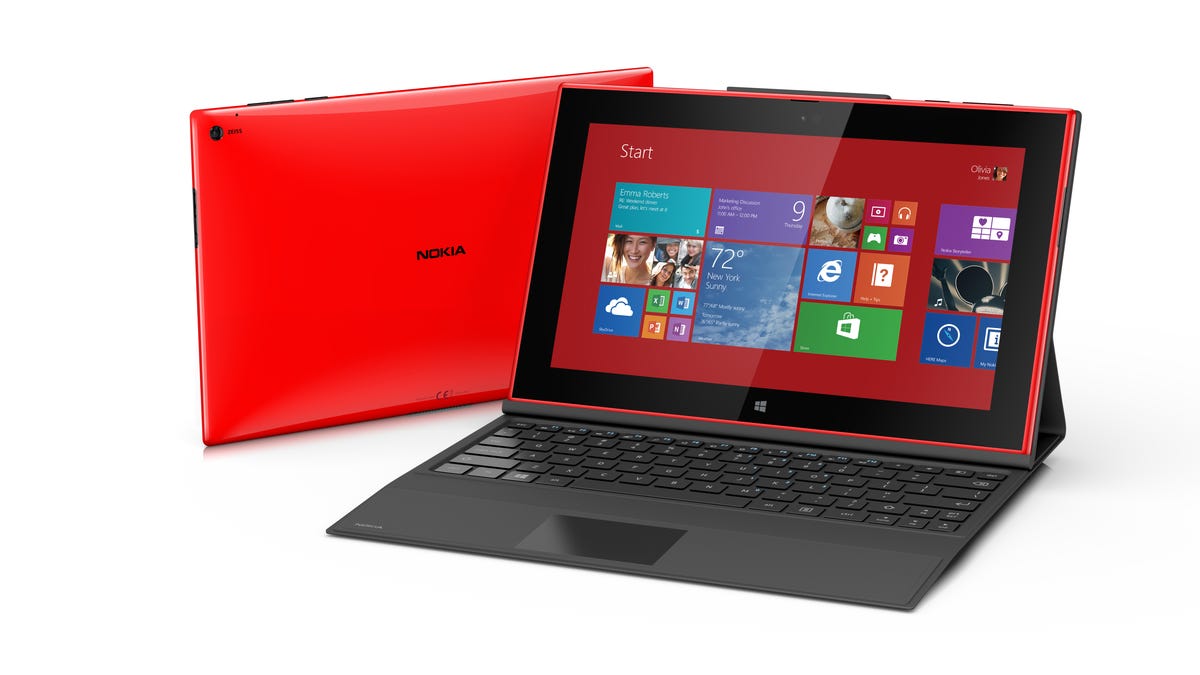Nokia's tablet turns Microsoft from BFF to archrival
<b>analysis</b> The Lumia 2520 tablet is a match for Microsoft's Surface 2, which may make for an awkward partnership.

Well, this is awkward.
Just hours after Microsoft's Surface 2 became available for sale, Nokia unveiled its own take on a Windows tablet, the Lumia 2520, putting some pressure on its soon-to-be parent company.
As Microsoft fans snapped up the Surface 2 in the US, Nokia introduced the Lumia 2520 alongside a number of jumbo smartphones and low-cost basic handsets halfway around the world in Abu Dhabi, United Arab Emirates.
Microsoft, of course, will eventually absorb Nokia's mobile devices business. But the introduction of the Lumia 2520, which runs the same Windows 8.1 RT operating system as the Surface 2, puts the once tight-knit partners in direct competition with each other.
Joe Belfiore, Microsoft's Windows Phone guru, previously told CNET that the acquisition of Nokia's handset business would mean fewer secrets. Once Nokia's phone business is a part of Microsoft, one can imagine there will be fewer redundancies of this sort.
Both run Windows 8.1 RT, which is the version of Windows that can't run legacy apps, an issue the original Surface RT faced when hitting the market. Why buy a Windows-based tablet when it can't run popular programs such as iTunes?
Both also offer sleek designs, USB ports, a 10.1-inch display, and that Windows-logo home button. Nokia even has its own $149 power keyboard cover accessory, although it's bulkier than Microsoft's Touch and Type covers.
Ifi Majid, who runs product marketing for Nokia's North American business, argued that Nokia took an approach that started with "mobile and worked its way down," while Microsoft is looking at the "business user and working its way up." The two companies come from different approaches, which result in different products.
"There's definitely room for both," Majid insisted.
But is there? Windows RT was an utter flop the first time around, with PC manufacturing partners abandoning the platform to focus on devices running on Windows 8. Microsoft itself took a $900 million "inventory adjustment" to account for unsold Surface RT devices.
Microsoft retooled and improved the second iteration of Surface (which dropped the RT name), but there's no guarantee it will do any better, particularly with the more complete, albeit more expensive, Surface Pro also available.
Nokia, meanwhile, threatens to beat Microsoft at its own game, taking a mobile approach that might actually be more successful.
Drawing from its colorful Lumia line of smartphones, the Lumia 2520 comes in cyan, red, black, and white. The red version comes in a glossy polycarbonate, or a fancy way of saying plastic, but pops when stacked next to a sea of black and gray devices.
Nokia made the conscious decision to include LTE as a standard feature, opting not to build a Wi-Fi-only version. The LTE connection is embedded into Qualcomm's 800 series quad-core Snapdragon processor, considered to be the fastest in the market. (The Surface 2 runs on an Nvidia Tegra 4 quad-core processor.)
It offers a brighter screen with wider viewing angles that are visible in sunlight. A fast-charging ability allows you to gain 50 percent of the battery life in just 40 minutes.
Where Nokia may have an edge is in distribution. While Microsoft is looking at the traditional consumer electronic retailers, Nokia is hoping to lean on its carrier relationships to get the Lumia 2520 in their stores. Nokia has worked to build up its relationship with partners such as AT&T and Verizon Wireless, and its tablet could get prominent shelf space and benefit from a pitch by the sales staff.
"Our goal is to work with carrier partners to give them more of a revenue opportunity," Majid said. "We're helping them sell data plans."
Majid insists that both devices only offer more ways for consumers to jump into the Windows ecosystem, and the two products represent different paths.
But it'll be interesting to see how the future of the Surface and Lumia tablet franchise evolves once Microsoft and Nokia's phone business are one big happy family.

